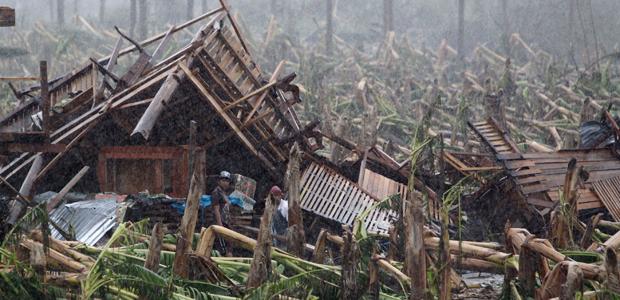Unusual Typhoon Leaves Southern Philippines Reeling
Typhoon victims stand outside their destroyed house and toppled banana trees swept at the height of Typhoon Bopha, in New Bataan town. (Photo: REUTERS/Erik De Castro)
Government agencies and rescue teams in the Philippines are warily watching Typhoon Bopha.
The violent storm blasted the southern part of the island nation earlier this week before moving out to sea.
But now forecasters are warning that Bopha might take a turn back toward land and hit the country again, farther to the north.
It would be a 1-2 punch for a country that gets way more than its share of natural disasters, from tropical storms to mention earthquakes and volcanic eruptions.
But typhoon Bopha seemed to come almost out of nowhere. It came outside of the usual typhoon season and hit a part of the country that’s off the usual storm track.
It was the country’s strongest storm of the year when it hit earlier this week. Combine that with a hilly landscape ravaged by mining and a population unprepared for a storm, and the awful result is more than 400 dead, nearly as many missing, and more than 300-thousand homeless.
Survivors told of chaos as the storm hit.
“We were hearing loud winds that night,” one man said. “We didn’t know where to run, the winds and the rain brought by the typhoon were so strong.”
Others told of shards of metal roofing being hurled through the air like machetes.
Officials in Compostela Valley, one of the worst hit provinces on the island of Mindanao, were considering mass graves for unclaimed bodies because of health concerns.
Officials have confirmed more than 250 dead in just that one region as rescuers continued to dig through mud and debris today in search of more bodies and any possible trapped survivors.
Philippines president Benigno Aquino III visited the region on Friday and promised to find ways to avoid a similar disaster in the future.
The country’s interior minister pointed to allegations of illegal mining and haphazard building on dangerous terrain, both of which are common in the region.
One thing most seem in agreement on is that the storm was highly unusual for this time of year and this part of the Philippines.
“For almost 50 years in New Bataan,” another survivor said, “this is the first time we’ve experienced such tragedy.”
The storm came amid of a rash of highly unusual extreme weather events around the world this year, and barely more than a month since another freak storm, hurricane Sandy, hit the US east coast, causing tens of billions of dollars in damage.
No one can definitively tie these or any other extreme weather events to climate change, but scientists say they’re the kind of thing the world can expect more of as the atmosphere warms.
And the question of a link was clearly on the mind of the Philippines’ envoy to the UN climate summit in Qatar this week.
On Thursday, envoy Naderev Sano delivered an impassioned plea to his fellow negotiators.
“There is massive and widespread devastation back at home,” Sano to the global gathering. “Hundreds of thousands of people have been rendered homeless, and the ordeal is far from over…. We have never had a typhoon like Bopha, which has wreaked havoc in a part of the country that has never seen a storm line this in half a century.
“And heart-breaking tragedies like this (are) not unique to the Philippines. I appeal to the whole world, I appeal to the leaders all over the world, to open our eyes to the stark reality that we face,” Sano said.
Sano’s plea and the unfolding disaster back in the Philippines don’t seem to have dissolved any of the gridlock at the Doha climate talk. As in years past, the meeting went far past its deadline, with negotiators struggling to achieve consensus on even the modest goals on the table.
